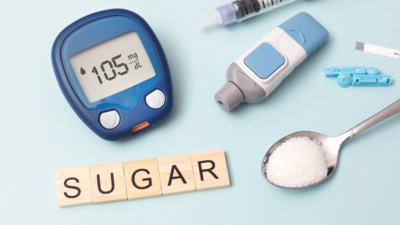ARTICLE AD BOX

Controlling blood sugar is paramount for preventing a cascade of serious health complications that can arise from consistently high glucose levels. When blood sugar remains elevated over time, it damages blood vessels and nerves throughout the body, leading to issues like heart disease, stroke, kidney failure, blindness, and nerve damage (neuropathy) in the extremities, which can result in foot ulcers and even amputations. Furthermore, poor blood sugar control weakens the immune system, making individuals more susceptible to infections and slower wound healing.
Diabetes is often seen as a disease of numbers — fasting glucose, post-meal glucose, HbA1c and the latest, time-in-range. But these numbers are not arbitrary; they are thresholds beyond which subtle, but serious damage to our body begins.
Even modest, sustained elevations in blood glucose can set off a cascade of complications that patients don’t realise — until it’s too late.
The Science Behind the Numbers
Diagnostic thresholds for diabetes are based on years of global research correlating blood glucose levels with complication risk. A fasting plasma glucose more than 125 mg/dL, post-meal (2-hour postprandial) more than 200 mg/dL, or an HbA1c above 6.4% signals diabetes — not because these numbers feel different, but because this is when the body begins to sustain measurable damage.This does not imply that fasting plasma glucose of 115 mg/dL or HbA1c of 6% is nothing to worry about. Even before full-blown diabetes, in the pre-diabetes range — fasting glucose 100–125 mg/dL or HbA1c 5.7–6.4% — organs begin to show stress, especially the pancreas, blood vessels, and nerves. These thresholds are designed to catch the disease early — before the complications become irreversible.
The Eyes: Where Sugar Leaves Its Mark First
Diabetic retinopathy occurs when elevated glucose weakens the tiny blood vessels in the retina, causing them to leak or proliferate abnormally.
Studies show that retinal damage correlates closely with HbA1c levels above 7%. Left unchecked, this can cause blurred vision or blindness — often without warning signs. That’s why annual retinal screening is recommended for all people with diabetes, even if their vision feels fine.
Nerves: Silent Victims of Glycaemic Variability
Peripheral neuropathy typically develops after years of blood sugar levels above the target range. Patients may feel tingling, burning, or numbness — especially in the feet — but sometimes the nerve damage is insidious and painless with loss of protective sensations.
A sustained HbA1c above 7.5% significantly increases the neuropathy risk. Since nerves regenerate slowly, prevention through good glucose control is essential.
Kidneys: The Quiet Organ Under Threat
Kidney damage starts subtly — with protein leaking into the urine (microalbuminuria) — even when blood tests for kidney function are still normal. This early sign is closely linked to poor glycaemic and blood pressure control. Clinical trials have shown that keeping HbA1c below 7%, alongside good BP, cholesterol levels and weight control, dramatically slows kidney decline.
Once nephropathy sets in, the progression to dialysis can be relentless.
Heart and Brain: Macro Damage, Micro Warning Signs
Diabetes accelerates atherosclerosis — the narrowing of arteries due to plaque buildup. This leads to heart attacks, strokes, and peripheral artery disease. People with diabetes are 2–4 times more likely to suffer cardiovascular events, especially with an HbA1c consistently above 7%. What’s less known is that poor glycaemic control also increases the risk of vascular dementia, due to repeated microvascular insults in the brain.
The Overlooked Spectrum
Emotional and Mental Health: Glycaemic highs and lows affect mood, cognition, and energy levels. Hypoglycaemia can cause anxiety and brain fog; chronic hyperglycaemia is linked with depression and irritability. Research increasingly recognizes that emotional well-being is tightly linked to blood sugar stability, and both should be addressed in diabetes care.Dense, but Fragile Bones: Paradoxically, many patients with type 2 diabetes have normal or even high bone density on a DEXA scan, yet suffer fragility fractures.
The culprit is the build-up of advanced glycation end-products inside the collagen matrix, which makes bone brittle—like sugared glass. Routine bone scans alone may thus underestimate fracture risk in poorly controlled patients.Immunity on a Sugar Crash: Hyperglycaemia blunts white blood cell movement and diminishes anti-inflammatory activity. The result is a sluggish immune response, explaining why people with diabetes succumb to severe infections more often and recover more slowly.
During the COVID-19 pandemic, poor baseline control emerged as an independent predictor of adverse outcomes—a stark reminder that glucose management is infection control.When Sugar Disrupts Intimacy: Sexual health is a barometer of vascular and neurological integrity. Up to 75 % of men with poorly controlled diabetes experience erectile dysfunction. Women are equally affected: recent endocrinology texts report female sexual dysfunction in 20–8% of women with type 2 diabetes, driven by microvascular injury, neuropathy and hormonal shifts.
Persistent hyperglycaemia thus erodes confidence, intimacy and fertility—complications rarely voiced in consultations unless proactively addressed.
Why Targets Matter
Leading health organizations recommend maintaining an HbA1c below 7% for most non-pregnant adults with diabetes. This threshold is not just a goal — it’s a protective boundary. Keeping within it has been shown to reduce the risk of microvascular complications by over 60%.With today’s tools — from advanced insulins to continuous glucose monitors and cardioprotective oral medications — staying in range is more achievable than ever. But the first step is awareness.
Final Thoughts
Diabetes isn’t just about high blood sugar. It’s about the organs quietly suffering under its weight — the eyes that dim, the nerves that fade, the kidneys that tire, the heart that falters, the mind that struggles, the bones that break, the immune defences that weaken, and the sexual well-being that erodes. The earlier you take control, the more damage you prevent.Authored by: Dr. Aasim Maldar, Consultant Endocrinologist and Diabetes Specialist, P. D. Hinduja Hospital and Medical Research Centre, Mahim, MumbaiHow poor glycemic control quietly damages your body
Symptoms, risks, treatments: All you need to know about diabetes



.png)
.png)
.png)
















 4 hours ago
7
4 hours ago
7









 English (US) ·
English (US) ·